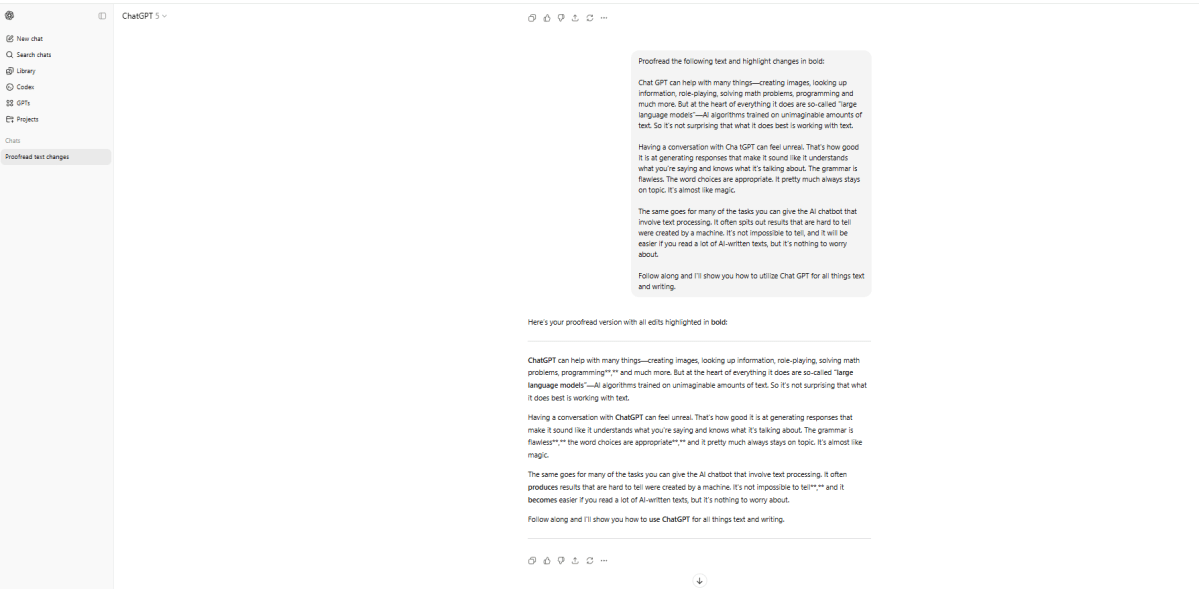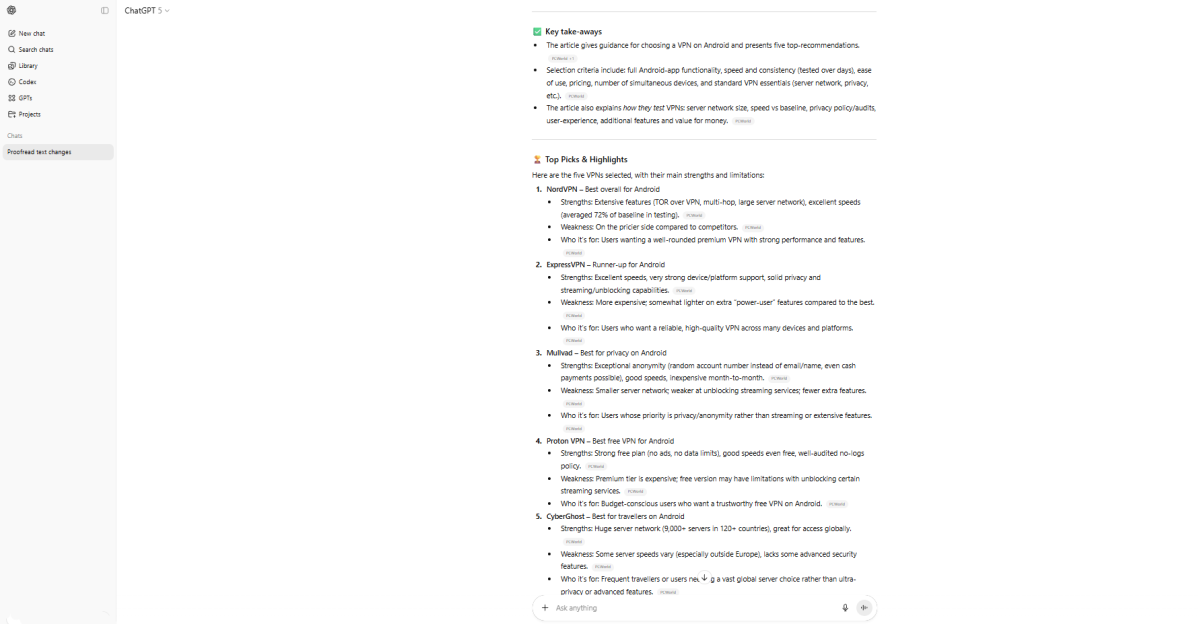ChatGPT can help with many things—creating images, looking up information, role-playing, solving math problems, programming and much more. But at the heart of everything it does are so-called “large language models”—AI algorithms trained on unimaginable amounts of text. So it’s not surprising that what it does best is working with text.
Having a conversation with ChatGPT can feel unreal. That’s how good it is at generating responses that make it sound like it understands what you’re saying and knows what it’s talking about. The grammar is flawless. The word choices are appropriate. It pretty much always stays on topic. It’s almost like magic.
The same goes for many of the tasks you can give the AI chatbot that involve text processing. It often spits out results that are hard to tell were created by a machine. It’s not impossible to tell, and it will be easier if you read a lot of AI-written texts, but it’s nothing to worry about.
Follow along and I’ll show you how to utilize ChatGPT for all things text and writing.

Sam Singleton
Proofreading
One of the simplest but most effective uses of ChatGPT is as a proofreader for your writing. By asking the chatbot to read a text carefully and respond with a corrected version, listing all the changes it has made with explanations, you’ll usually get a text that is similar but with grammar and spelling mistakes corrected and with other small changes suggested to make the text better.
My suggestion is not to trust the AI blindly and copy the result, even if it is the easiest thing to do. It happens every now and then that it inserts new errors that were not there in your original text, even if it’s completely correct with the changes it shows it has made.
Instead, rewrite your text yourself based on Chat GPT’s suggestions, and you will ensure that only the necessary changes are made. In return, you can get a better eye for typical mistakes you make when writing, and actually become better at writing.
Having worked a lot with this myself, I have some tips that in my experience make ChatGPT do a better job with the correction. I’ve created a GPT (see below) with customized instructions. I used to have more intricate instructions, but have found that these more basic ones work better for me. This is what they look like right now:
“Proofread the following text and correct any spelling and grammar errors. Show all changes directly in the text in bold and in a list after the corrected text. Stick to correcting errors – do not make any other improvements. The language should follow the author’s language and be neutral.“
As I write journalistic texts, I ask ChatGPT to follow the author’s language recommendations—you can of course skip that. If you prefer, you can also ask it to make major changes, but personally I want a proofreader to stick to just finding errors and mostly pointing out if part of the text is easily misinterpreted or incomprehensible.
If you don’t subscribe to ChatGPT Plus, you can add instructions like these to a “project” instead, which even free accounts have access to. They will then be included in any chats you start in the project.

Sam Singleton
Improve and change your texts
If you are writing on a type of text you don’t feel you master very well, you can let ChatGPT help you. You can try using a description or keywords associated with the type of text you are looking for, for example “rewrite this text to look like it was written by a lawyer, use legal terminology and be polite and matter-of-fact but still sharp”, or “rewrite this text so that it has a consistent tone and voice”.
You can also upload a file with a text whose style you like and ask ChatGPT to rewrite another text in a similar style to the uploaded document. How well this works varies, but you can improve the results by, for example, asking ChatGPT to “read carefully” and “explain why you are making the different changes”—the latter can help the AI not to lose the thread, which can sometimes happen with longer texts.
In fact, splitting up longer texts and working on one part at a time can often give better results. One chapter, section, or even paragraph at a time makes it easier to get ChatGPT to stay focused on making improvements to that particular part.
It’s a natural consequence of how language models work. They generate their answers one token (a word or part of a word) at a time based on the likelihood of a particular token following what has been generated so far and input from the user.
If you type “What is the capital of Angola?”, there is a high probability that the first generated word of the Chat GPT is “Angola”. If it is, there is a high probability that the next word is “capital”. If so, there is a high probability that the next one will be “Luanda”, and so on. The longer the text, the greater the likelihood that the algorithm will “forget” the instructions first and go off on a tangent.
If you’re more interested in the big picture, you should of course paste the whole text you’re working on instead. Then you can, for example, ask it to read through and suggest changes that make it better on an overall level. This is what such an instruction might look like:
“Critically review the following text and make suggestions on how to improve it so that [the arguments are stronger / it is easier to read and understand / it has a clear thread].”
Another thing ChatGPT can help with is adding references and examples. For references, it’s important that you double-check the sources and make sure they are correct—all language models have a tendency to ‘make up’ quotes, sources, and even authors. You’ve probably seen on the news one of the many occasions when, for example, a government agency has published a report that turns out to contain AI ‘hallucinated’ data.

Sam Singleton
Summarize and translate
One of the most common uses of modern AI services like Chat GPT is to summarize large amounts of information. For example, not having to read through page after page of a report to get a picture of the key insights can save an incredible amount of time.
Chat GPT is good at this, but far from perfect. Many politicians, civil servants, and consultants have been left scratching their heads after blindly trusting an AI summary that later turned out to be full of errors.
For specific claims and figures, it’s therefore best to look them up. The easiest way is to search the text, but be aware that numbers with decimals and thousands may be formatted differently (if the text says “9,200,000” and Chat GPT summarizes it as “9.2 million”, it may be difficult to find).
Chat GPT is also good at translating between different languages, with results that are more reader-friendly than older automated translations. There can still be some errors, especially when translating to or from less common languages or with very technical subjects, but on the whole they are usually correct. Unlike summaries, it will be harder to check yourself, so keep that in mind.
Creating new texts
Many people also use ChatGPT to write completely new texts. Some do this to save time with texts where personal style is not so important, others to write texts they don’t consider themselves good at, or when they have no idea where to start.
If you start by uploading or pasting examples of your own texts and ask ChatGPT to analyze the style, you can then ask the chatbot to write a new text in the same style, which may produce results that are at least reasonably similar to something you could have written yourself.
But sometimes this is not necessary at all. It’s often irrelevant whether a text sounds like it was written by you—the important thing is that it is written and conveys what it should. For example, if you are writing an email to your local authority to complain about something, you can ask ChatGPT to write it for you, and simply sign and send it if you’re happy with the result. However, you should read it carefully first to make sure it doesn’t say anything incorrect or sound fake.
ChatGPT as a sounding board to get ideas
Even if you don’t want ChatGPT to take over and write for you, you may find the chatbot useful to get you started or to get you going if you’re stuck. Share what you already have and ask it to make some suggestions on how to start/continue.
The suggestions don’t even have to be useful in and of themselves—in fact, they often leave a lot to be desired—but getting a few ideas can be enough to get your own creative juices flowing. This kind of idea exchange where ChatGPT acts as a sounding board is what it’s really good at, and it’s perfect when you don’t have a human available to bounce ideas off.
My only caveat is that the design of the language models means that the suggestions generated can never be truly innovative. Even if it sounds inventive to your ears, it’s simply much more likely to mimic and come up with suggestions that are common than it is to “invent” something completely new.
Uploading and referencing other texts
ChatGPT has an upload feature that you can utilize in several ways when working with text. You can upload examples of your own texts to ask the chatbot to use your style. Another use is to summarize texts. Uploading a PDF saves you having to copy and paste a long text.
You can also upload texts and ask Chat GPT to do more complex tasks, such as comparing and analyzing the content of several files or finding suitable references for a text you have written among a number of uploaded files. Remember to double-check factual claims.
Use projects to keep your chats organized
All ChatGPT users now have access to a feature called projects. The idea isn’t new, it’s been around in other AI chatbots, and Open AI has thankfully been inspired by them. Projects work as a way to organize all the chats on different topics. A bit like folders in your computer’s file system, but with an additional feature that allows each project to be customized.
Namely, once you’ve created a project, you can add instructions to be included in each new chat you start in that project. For example, if you create a project called Proofreading and add instructions asking the AI to proofread all the texts you share, you won’t have to rewrite (or copy and paste) the instructions each time.
You can also upload files to the project, which all chats under the project can then access and refer to.
If you have a lot of projects, you can make them easier to find by selecting from a bunch of available icons and one of a number of colours. One unfortunate detail is that it’s not yet possible to rearrange the order of projects—they are always sorted by creation date, with the oldest project at the bottom and the most recent at the top.
Finally, you can use the Share feature to invite others to a project, so they can also access all conversations in the project and contribute or upload more files.

Sam Singleton
GPTs provide greater freedom to customize your virtual editor
One of the benefits of paying for a ChatGPT Plus account is that you get access to the GPTs feature. These are specially customized versions of the chatbot that you can use yourself or share with others. You add instructions to be included in each conversation and can upload files for the chatbot to reference or retrieve information from. You can also select a preferred model and choose whether the GPT should have access to web search, canvas, image generation, and code interpreter and data analysis features.
For more advanced use, GPTs can also be extended with something called actions. These allow the GPT to contact external servers to automate various tasks. For example, if you use Home Assistant to control smart home gadgets, you could create a GPT that connects to that server, so you can use the ChatGPT to switch lights on and off and so on—these are more advanced skills that are beyond the scope of this article, but you can see how it opens up a potential world of possibilities.
This articles is written by : Nermeen Nabil Khear Abdelmalak
All rights reserved to : USAGOLDMIES . www.usagoldmines.com
You can Enjoy surfing our website categories and read more content in many fields you may like .
Why USAGoldMines ?
USAGoldMines is a comprehensive website offering the latest in financial, crypto, and technical news. With specialized sections for each category, it provides readers with up-to-date market insights, investment trends, and technological advancements, making it a valuable resource for investors and enthusiasts in the fast-paced financial world.


